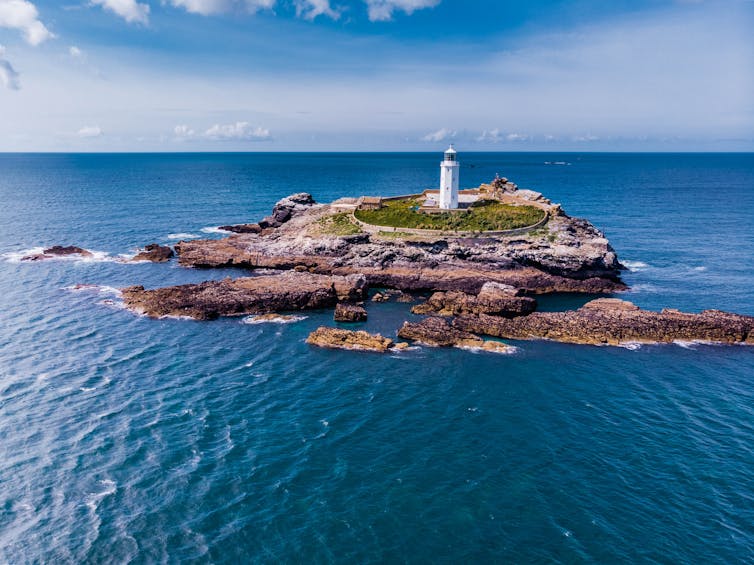What ancient ice sheets can tell us about future sea level rise
When visiting Godrevy beach on the north Cornish coast, most people look out to sea at the lighthouse, surfers and seals rather than the cliffs behind. But these cliffs hold a history of past climate and sea level that is incredibly valuable to scientists like me who are trying to determine how quickly sea level is going to rise in the future.
Scramble up the slate rocks a few metres and you’ll reach a flat platform cut by waves breaking over 100,000 years ago. On top, there’s a cliff of sand and pebbles, an incredibly clear indicator of where the shoreline used to be, several metres higher than it is today.
Beaches like this exist all around the Cornish coastline, near Falmouth at Bream Cove and at the furthest western point near Lands End at Porth Nanven.
Searching for the source of these higher sea levels takes us to the poles. In a climate similar to today, the Antarctic and Greenland ice sheets retreated, raising global sea level. Although exactly where this ice was lost from remains a mystery that continues to frustrate scientists.
Godrevy lighthouse, Cornwall, UK.
Vivi_784/Shutterstock
Local science, global stories.
This article is part of a series, Secrets of the Sea, exploring how marine scientists are developing climate solutions.
In collaboration with the BBC, Anna Turns travels around the West Country coastline to meet ocean experts making exciting discoveries beneath the waves.
When ice gets trapped on land as giant ice sheets, it causes the sea level to change, but it doesn’t change by the same amount all around the planet. Like the moon, the gravity of the ice sheets pulls the ocean towards them, causing sea levels to rise near to the ice sheets.
The opposite happens when they melt. As the ice on Greenland retreats today, it’s causing the sea level nearby to fall, rather than rise. Only as far as Scotland, some 1,500 miles from Greenland, does this sea level fall switch to a sea level rise.
The cliffs at Godrevy reveal historic sea level rise.
Ed Gasson, CC BY-NC-ND
This gravity effect leaves behind a distinctive fingerprint in past sea level markers, such as raised beaches and fossil coral reefs. By piecing together data from around the world we can work out the source of past high sea levels.
The raised beaches such as those in north Cornwall are likely caused by the retreat of ice from Antarctica, rather than the ice from Greenland. But direct evidence for ice loss from Antarctica has proven very hard to come by.
I’m involved with an international drilling project that aims to solve this mystery. Following two challenging seasons of drilling, our team of scientists and engineers will return to Antarctica in late 2025 and attempt to recover sediments from deep underneath the ice, to analyse for signals of past ice retreat.
If we’re lucky, we’ll recover records from warm climates millions of years ago. This will help us understand how the west Antarctic ice sheet may change in the future as our climate continues to warm.
Drilling down
Next winter, this international team is travelling to Scott Base, a New Zealand research station at the edge of the Ross ice shelf in west Antarctica. From there, the journey continues over 500 miles to the other end of the ice shelf, an extremely remote corner of an already remote continent.
Everything we need is taken across the ice in a convoy of tracked snow vehicles. A hot water drill is used to make a small hole through the 500m ice shelf, providing access to the sediment below. Up to 200m of valuable sediment core will be retrieved with a custom-designed drilling system.
The geological data contained in these sediments will help us to improve models and refine our predictions of how sea level will rise in the future. As the amount of carbon dioxide in the atmosphere increases, it is as if we are rapidly moving backwards through geological time.
Today, there is as much CO₂ in the atmosphere as during a geological epoch known as the mid-Pliocene, more than 3 million years ago. The average estimate for the mid-Pliocene is a concentration of around 400 parts per million (ppm), a value we reached only 12 years ago.
We’ll exceed the highest concentrations of the Pliocene this year. The next warmest interval is probably the mid-Miocene, 12 million years earlier.
Back in Cornwall, some communities are already planning for the effects of sea level rise. In Bude, local people have come together to form a “climate jury”, a panel chosen to give local people a voice as to how to best manage and reduce the impacts of a rising sea.
This approach could be adopted by other communities at risk from sea level rise, alongside other adaptations. Hopefully, the world can avoid a return to the very high sea levels that formed the raised beaches at Godrevy.
Don’t have time to read about climate change as much as you’d like?
Get a weekly roundup in your inbox instead. Every Wednesday, The Conversation’s environment editor writes Imagine, a short email that goes a little deeper into just one climate issue. Join the 45,000+ readers who’ve subscribed so far.
Ed Gasson receives funding from The Royal Society and the Natural Environment Research Council.



